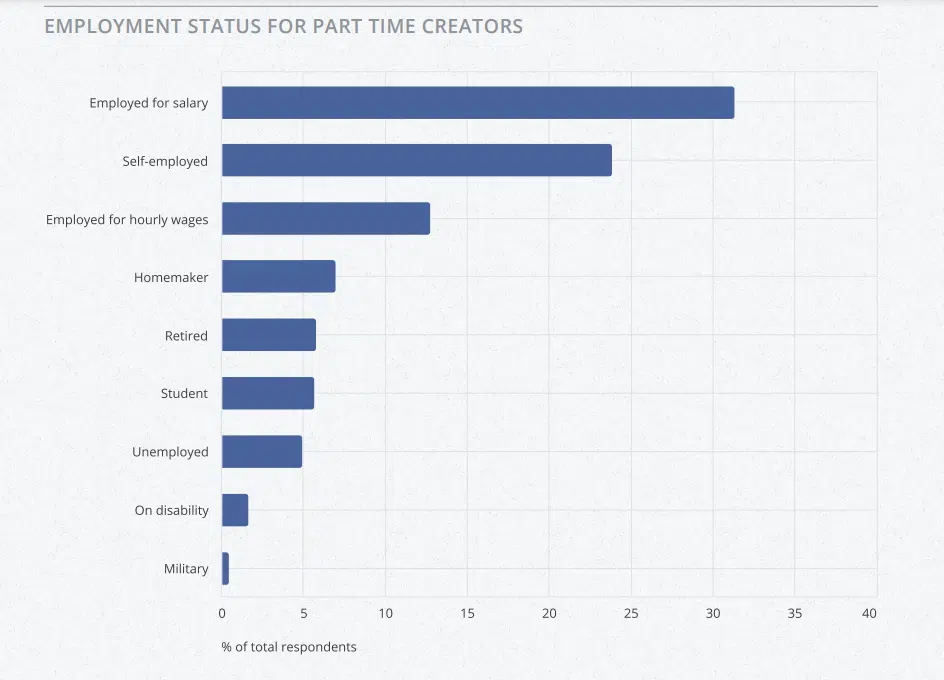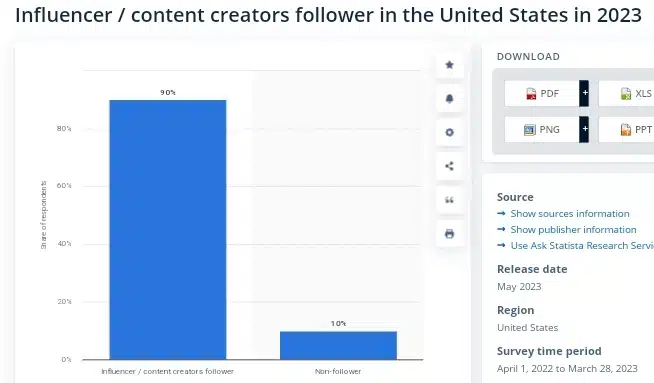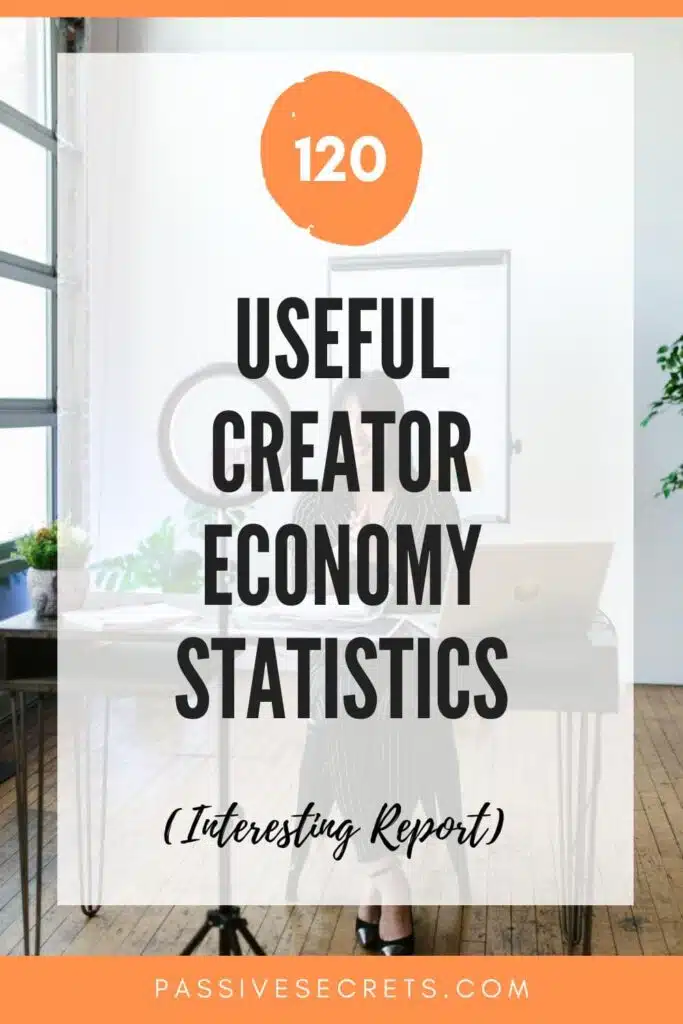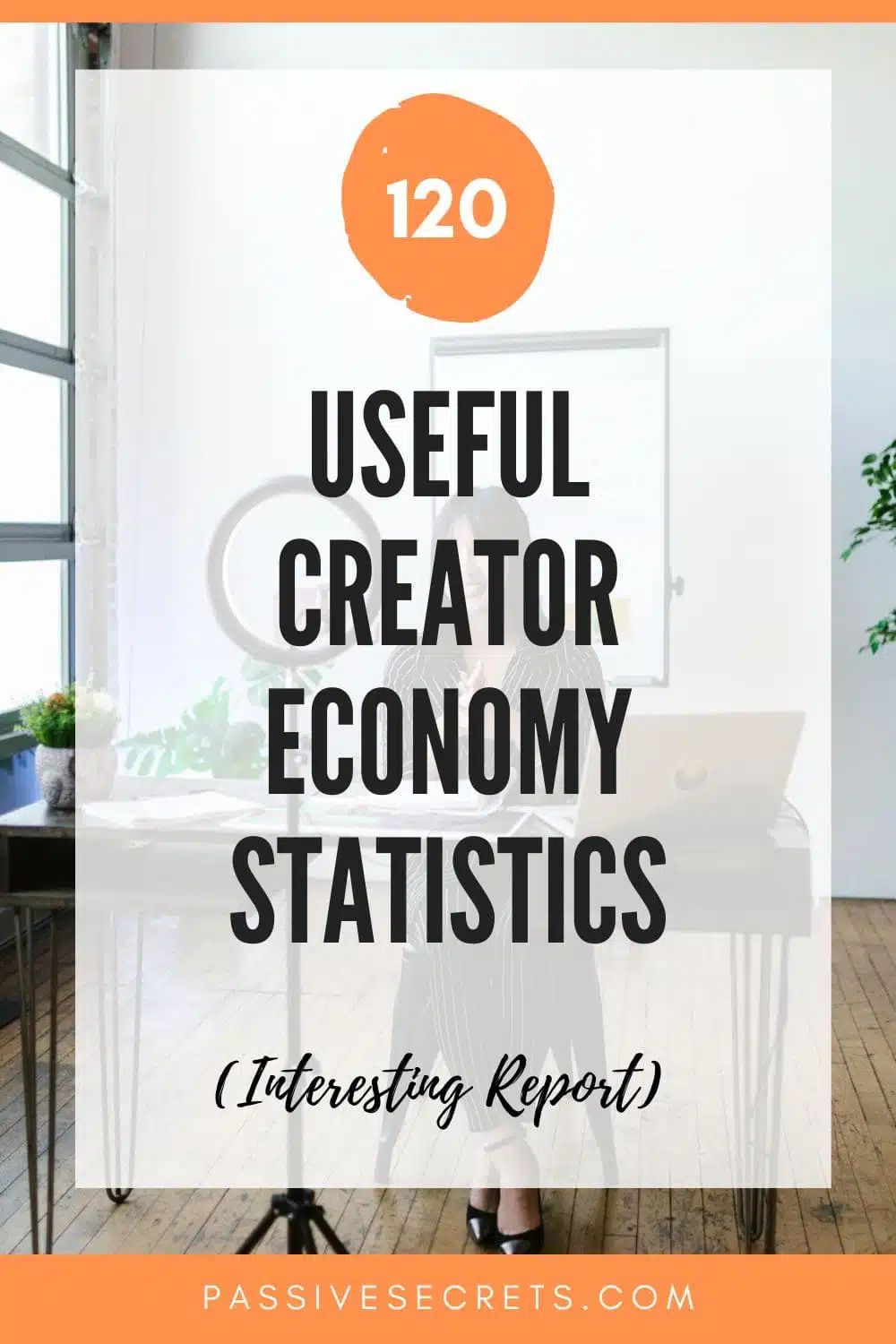
The creator economy has transformed how we interact with digital content, allowing people to turn their passions into profitable ventures.
This dynamic sector, valued at $104.2 billion, is expected to double by 2027.
The creator economy has created diverse content creators, from independent writers and artists to social media influencers and YouTubers.
There are over 200 million active content creators in the world.
The creator economy is revolutionizing how we consume content and reshaping the digital landscape, fostering innovation, creativity, and economic growth. These creator economy statistics show just how much the industry is evolving.
Top Creator Economy Statistics
- The creator economy market is set to exceed USD 600 billion by the end of 2036.
- Goldman Sachs research forecasts that the total addressable market for the creator economy will double in size over the next five years, reaching $480 billion by 2027.
- There are currently 200 million content creators worldwide.
- In 2024, 54.9% of creators identified as full-time creators, 3% more than in 2023.
- In the creator economy market, the digital content creator segment is expected to gain a significant share of 30% from 2024 to 2036.
- Millennials constitute 42% of the Creator Economy, while Gen Z represents 14%.
- 68% of part-time creators make less than U.S. $1,000 annually, while only 3% earn over U.S. $50,000 annually.
- More than half (52%) of creators who earn between $50,000 and $100,000 per year spend 10 hours or less per week creating content.
- The Influencer Marketing Industry is projected to expand to around $24 billion by the close of 2024.
- On average, brands spend $257 per collaboration with influencers.
- Influencers constitute only 14% of the overall creator economy.
- Male content creators in Australia earn an average of $150 per hour, while female creators report $110.
- The average annual salary for UK creators is £28,000, equivalent to £14.36 per hour.
- Europe’s creator economy market was valued at US$10.35 billion in 2023 and is projected to reach US$41.17 billion by 2030.
- The Creator Economy expanded by 34 million fresh creators in the United States, marking a 40% increase.
- The YouTube Partner Program now includes over 3 million creators.
Latest Creator Economy Statistics and Facts
1. An estimate from mid-2022 places the size of the creator economy at $104.2 billion. (source)
2. Over the past two years, the global creator economy has surged over 165 million new participants. With notable increases in the U.S. (+34 million), Spain (+10 million), South Korea (+11 million), and Brazil (+73 million). (source)
3. In 2023, the creator economy market size was valued at USD 200 billion, largely attributed to the impact of the COVID-19 pandemic. (source)
4. The creator economy market is set to exceed USD 600 billion by the end of 2036. With an anticipated annual growth rate of 23% between 2024 and 2036. (source)
5. Social media creators can expect significant revenue growth from 2021 to 2024, with a minimum of three times the earnings from tipping (from $53.33 million to $160 million), subscriptions (from $90 million to $270 million), and merchandising (from $150 million to $450 million). (source)
6. Goldman Sachs research forecasts that the total addressable market for the creator economy will double in size over the next five years, reaching $480 billion by 2027. (source)
7. The top 10 types of creator economy services collectively generated approximately $9.50 billion in revenues in 2022, according to data from influencer marketing software company NeoReach. (source and source)
8. According to LinkTree’s report, there are currently 200 million content creators worldwide. (source)
9. Venture capital funding for creator economy startups declined to $270 million in the fourth quarter of 2022. Down from a peak of $1.70 billion in the second quarter of 2021. (source)
10. A study by Adobe in August 2022 suggests a higher count of 303 million creators, with over half joining the creator economy in 2020. (source)
11. Brand sponsorships remain the primary revenue stream for most creators in 2023, although many are diversifying into developing their own brands. (source)
12. YouTube creators Logan Paul and KSI’s energy drink Prime, which generated nearly $250 million in sales last year, made history by airing the first creator-led brand Super Bowl commercial. (source)
13. In 2024, 54.9% of creators identified as full-time creators. This is 3% more than that of 2023. (source)
14. A survey by ConvertKit revealed that nearly half (46.7%) of content creators consider themselves “full-time,” while almost 43% are part-timers and 11% are hobbyists. (source)
15. Salaried employees are the most common professional status among individuals who are not full-time creators. (source)

16. About one in four individuals contribute to online spaces as creators, engaging in photography, videography, and creative writing. (source)
17. Creators aged 31-40 represent the largest age group, constituting approximately one-third of all creators. (source)
18. Female creators outnumber male creators, with 64% of creators identifying as women and 35% as men, while 1% identify as non-binary. Also, 67% of full-time creators are women. (source)
19. Many part-time creators and hobbyists (12% and 7%, respectively) list homemaking as their other or primary occupation. (source)
20. Most creators (61%) are in a committed relationship, married or domestic. Notably, full-time creators are more likely to be married (63%) than hobbyists (48%). (source)
Also, a significant majority of creators, full-time (55%) and part-time (nearly the same percentage), have at least one child.
21. Around 24% of creators began their journey during the pandemic. However, While many creators entered the field during the pandemic, many part-time and hobbyist creators started creating more than full-timers. (source)
22. Educator is the most common content creator type. It is followed by blogger, coach, writer, and artist, respectively. (source)
23. Animated links are proving to be a highly effective tool for creators, driving a remarkable 85% increase in click-through rates compared to static links and helping to capture audience attention and boost engagement. (source)
24. Male creators earn an average salary 1.88 times higher than female creators. (source)
25. In 2022, companies supporting the creator economy generated significant revenues from various services, including merchandising sales, subscriptions, blockchain services, and ad platforms. (source)
26. In the creator economy market, the digital content creator segment is expected to gain a significant share of 30% from 2024 to 2036. (source)
27. Tutorials, how-to videos, live streams, and influencer vlogs were the most popular video content types worldwide in the third quarter of 2023. Online videos reach 92.3% of global internet users, making them widely consumed digital content. (source and source)
28. The video streaming segment is anticipated to account for 30% of the global creator economy market share from 2024-2036, driven by consumer demand for high-quality content. (source)
29. Most creators (almost 75%) opt for video content, followed by visual content (51%), written content (48%), and audio content (42%) as the most popular formats, indicating a diverse range of creative expressions. (source)
30. Millennials constitute 42% of the Creator Economy, while Gen Z represents 14%. (source)
31. Freedom of expression is the primary motivation for nearly half of all creators (48%), while less than one-third are primarily motivated by monetary incentives. (source)
32. Creators who produce daily content or spend 10+ hours per week creating report higher overall happiness. (source)
33. Most creators (69%) and influencers (84%) view online content creation as a unique and essential creative outlet that they cannot replicate elsewhere. (source)
34. Half of influencers consider social media usage and content creation as crucial to their mental well-being, prioritizing it over activities like listening to music (31%), exercising (30%), and spending time in nature (27%). (source)
35. One-third of US consumers, and over half of Gen Z and millennials, consider content creators’ opinions when purchasing. (source)
36. In 2024, users have streamed 10.4 million+ hours of content, viewed a whopping 1.7 billion TikTok videos, and shared 676,488 photos on Instagram. (source)
Independent Creator Statistics
37. Independent creators are predominantly young and male, with 63% aged 40 or younger and 53% male. However, older generations (Baby Boomers and Gen X) are increasingly represented, growing from 27% to 35% between 2022 and 2023. (source)
38. Most independent creators (70%) work part-time in the creator economy, while 30% work full-time as independent digital content creators. (source)
39. Most beginner creators (59%) haven’t monetized their content, while 35% have earned some income but not enough to support themselves. Only 6% have achieved significant success, earning over $10,000. (source)
40. Lockdown measures and the transition to remote work have notably boosted online engagement. Leading to increased demand for content on platforms like YouTube, TikTok, and others created by independent creators. (source)
41. The number of independent creators earning money through creating and distributing digital content experienced a slight decline. Decreasing from 8.2 million in 2022 to 8.1 million in 2023. (source)
42. Nearly half (46%) of independent creators find it challenging to achieve success and a significant proportion (41%) experience burnout. This highlights the difficulties and pressures faced in the creator economy. (source)
43. 62% of niche creators find that specialization boosts engagement and reach. They’re also more likely to collaborate with brands (37% vs. 26%) and earn over $100K annually (7% vs 5%) than non-niche creators. (source)
44. 40% of Americans think they have the potential to become a successful content creator, driven by financial goals (39%), passion sharing (37%), and independence (35%). Most (58%) consider content creation a legitimate career, and 49% believe it can provide a decent living. (source)
45. Most creators (58.3%) reported struggling with monetizing their content in 2024, slightly improving from the 61.5% who faced similar challenges in 2023. This indicates a gradual easing of monetization difficulties in the creator economy. (source)
46. Most creators (73.1%) are optimistic about their income growth in 2024, expecting improvements due to new monetization opportunities and diversifying content across platforms, a slight increase from last year’s outlook. (source)
47. A significant majority (77%) of creators who monetize their content feel fairly compensated due to platform programs. However, 62.3% still struggle to align their content creation with effective monetization strategies, highlighting a persistent challenge in the creator economy. (source)
48. Most creators (92%) generate most of their income through partnerships with brands, with the tech and business niches being the most lucrative, earning over $150,000 annually for top creators in these fields. (source)
Creators Earnings Statistics
49. There’s no direct correlation between creators’ work hours and revenue. However, the data shows that:
– Most low-earning creators (<$100/year) work less than 5 hours/week.
– Mid-tier creators ($50K-$100K/year) work less than 10 hours/week.
– Higher-earning creators ($100K-$500K/year) tend to work more than 10 hours/week. (source)
50. In the past year, half of the creators monetized their content, but earnings varied widely: 72% made less than $500, 17% made $500-$5,000, and only 11% made over $10,000, with 2% surpassing $50,000. (source)
51. The average monthly earnings for creators have risen by over 25% since early 2022, indicating significant revenue growth. (source)
52. Twitter now pays creators 97% of revenue up to $50,000 in lifetime earnings through paid subscriptions, with a reduction to 80% thereafter. (source)
53. Only 4% of creators worldwide earn over $100,000 annually, qualifying them as professional creators, while most fall under the amateur or hobbyist category. (source)
54. 12% of full-time creators make over U.S. $50,000 annually. However, a majority (46%) of full-time creators make less than $1,000 annually. (source)
55. 68% of part-time creators make less than U.S. $1,000 annually. Only 3% earn over U.S. $50,000 annually. (source)
56. Only 9% of independent creators earned over $100,000 last year, while the majority (71%) made less than $30,000, with 34% earning under $5,000 and 37% earning between $5,000 and $30,000. (source)
57. More than half (52%) of creators who earn between $50,000 and $100,000 per year spend 10 hours or less per week creating content. (source)
Creator And Influencer Industry Statistics
58. The Influencer Marketing Industry is projected to expand to around $24 billion by the close of 2024. (source)
59. The worldwide influencer market is estimated at $21.1 billion. (source)
60. Over 50 million individuals globally identify themselves as content creators. (source)
61. Software platforms dedicated to influencer marketing raised over $800 million in funding in 2021. (source)
62. The global count of companies in the influencer marketing sector surged by 26% in 2021, totaling 18,900 firms specializing in such services. (source)
63. More than a quarter of brand marketers plan to allocate their budget to influencer marketing in 2022. (source)
64. 63% of brand marketers aim to employ AI in managing their influencer campaigns, with two-thirds focusing on AI for influencer identification. (source)
65. A recent survey by Statista (2023) found that a vast majority (around 90%) of online users in the United States follow influencers or content creators, leaving only a small fraction (10%) who do not engage with them online. (source)

66. A survey revealed that over 85% of respondents still consider influencer marketing an effective strategy. (source)
67. TikTok has become the most favored platform for influencer marketing, used by 69% of brands, surpassing Instagram for the first time. (source)
68. 60% of brands planning to invest in influencer marketing intend to increase their budget in 2024. (source)
69. Nearly a quarter (26%) of respondents plan to allocate over 40% of their total marketing budget to influencer campaigns. (source)
70. On average, brands spend $257 per collaboration with influencers. (source)
71. Instagram influencers typically charge $363 for collaboration, encompassing various content formats like static feed posts, reels, and stories. (source)
72. TikTok influencers charge an average of $460 for a collaboration. (source)
73. Influencers constitute only 14% of the overall creator economy. (source)
74. 44% of brands prefer nano-influencers (1K-10K followers) as their primary partners, followed by 25.7% opting for micro-influencers (10K-100K). (source)
75. More brands now opt to pay influencers rather than provide them with free product samples. (source)
76. A 2023 survey of US-based creators revealed that 21% utilize AI for content editing, while another 21% use it for generating visual content like images and videos. Meanwhile, only 5.5% of respondents reported not using AI in their creative processes. (source)
Creator Economy Statistics By Country
Australia
77. In Australia, 37% of creators are highly motivated to produce content advocating for causes they believe in. Climate change is topping the list, followed by social justice, diversity, and inclusion. (source)
78. Almost half of Australian creators (46%) expect an income increase in the next two years, while a larger proportion of Gen Z creators (61%) have similar expectations. (source)
79. Adobe’s study found that nearly half (48%) of Australian creators monetize their content, with a significant 79% starting this process within the past year. (source)
80. Australians generate a significant annual profit of $9 billion by utilizing digital tools to create and export social media content globally. (source)
However, the report by AFR Intelligence, sponsored by YouTube, highlights that Australia’s creator economy growth could stall without dedicated investment and better comprehension.
81. Approximately 38% of Australian monetizers have experienced an increase in earnings over the past two years, and a significant majority (77%) expect further income growth in the next two years. (source)
82. Almost half (49%) of Gen Z monetizers prefer starting their own creative ventures over pursuing higher education, indicating a shift in priorities and career aspirations. (source)
83. Around 30% of Australian creators are driven by the earning potential and the desire to turn content creation into a full-time profession. (source)
84. NFT and VR technologies are gaining traction among Australian Gen Z creators, offering new avenues for their creative content. (source)
85. There remains a pay gap between male and female Australian creators, with males earning an average of AU$157 and females AU$115. (source)
86. Influencers represent only 12% of Australian creators, reflecting a small fraction of the overall creator economy. (source)
87. Australia saw a significant increase of 3 million new creators, reaching 6 million, constituting 23% of the Australian population. (source)
88. YouTube is the most utilized digital platform, contributing $890 million to Australia’s GDP in 2022. Oxford Economics says this is through direct job creation and other economic benefits. (source)
89. Male content creators in Australia earn an average of $150 per hour, while female creators report $110. (source)
90. There is a strong international demand for Australian creative content, with over 90% of watch time on Australian YouTube channels originating from outside the country. (source)
91. Fueled by COVID lockdowns, Australian creators have turned to platforms like YouTube, Spotify, TikTok, and Instagram to share their digital artistic expression with a global audience. (source)
United Kingdom
92. Since 2020, over 8 million new creators have joined the creator economy in the UK, bringing the global total to 303 million creators, an increase of 165 million. (source)
93. Approximately one in four Britons consider themselves content creators, making up around 16.5 million creators in the UK, about a quarter of the population. (source)
94. Despite most UK creators having full-time employment, creating content is a popular side hustle. UK influencers earn an average of £117.48 per hour, the highest among several surveyed countries. (source)
95. About 30% of UK creators aim to become influencers, while 35% aspire to monetize their online content through their own businesses. (source)
96. Most (65%) UK creators have other full-time jobs alongside content creation. (source)
97. The average age of UK creators is 37, with over a third being over 40, indicating a diverse age range in this field. (source)
98. The average annual salary for UK creators is £28,000, equivalent to £14.36 per hour. (source)
99. In 2021, YouTube’s creative ecosystem contributed over £1.4 billion to the UK’s GDP and sustained over 40,000 full-time equivalent jobs. (source)
Africa
100. The market size of the Africa Creator Economy was valued at US$3.08 billion in 2023 and is projected to reach US$17.84 billion in 2030. With a compound annual growth rate (CAGR) of 28.5% from 2023 to 2030. (source)
101. Key drivers behind the growth of Africa’s creative economy include the expanding youth population, the surge in social media usage, increased adoption of digital payments, etc. (source)
102. Regarding platform type, video segments held the largest portion, accounting for over 41% in 2021. The popularity of video content creation and distribution on platforms like YouTube, TikTok, and Instagram is on the rise among African creators. (source)
Africa’s creator economy is set for significant expansion in the upcoming years as advancements in the digital sphere continue to unveil fresh market prospects.
Europe
103. Marketing expenditure for European creators has surged by over four times in the last five years. In 2020, investments soared to 1.3 billion euros, marking a 14% rise from the previous year’s figure of 1.2 billion euros. (source)
104. Subscription-based revenue models are predicted to be the primary drivers in Europe’s creator economy market in 2024, offering creators a dependable and sustainable income source. (source)
105. Recent developments in the creator economy include:
- IAB’s research report on the advertising potential of the creator economy (Dec 2023)
- Snap Inc.’s new programs and features to support creators (Nov 2023)
- Meta’s ad-free subscription option for EU, EEA, and Switzerland users (Oct 2023)
- Kojil’s AI integration for Link in Bio app (Sep 2023)
- Mastercard’s Web3-based Artist Accelerator program for music creators (Jan 2023) (source)
106. The European Creator Economy Market is forecasted to hit USD 13.4 billion by the end of 2024. It is anticipated to climb to USD 84.1 billion by 2033 at a CAGR of 22.6%. (source)
107. Video-sharing platforms are expected to lead the market in 2024, serving as crucial facilitators in the European creator economy. (source)
108. Europe’s creator economy market was valued at US$ 10.35 billion in 2023 and is projected to reach US$ 41.17 billion by 2030. (source)
109. The European creator economy market is segmented by content type and revenue model. Video content, such as YouTube, TikTok, and live streams, is gaining immense popularity among European creators and audiences. (source)
America
110. The Creator Economy expanded by 34 million fresh creators in the United States, marking a 40% increase. (source)
111. Brazil witnessed a surge of 73 million new creators, with South Korea and Spain also experiencing significant growth, adding 11 million and 10 million creators, respectively. (source)
Asia and Oceania
112. The market size of the creator economy in Asia and Oceania is estimated at $18.35 billion in 2023. It is forecasted to reach $52.17 billion by 2030, growing at an annual rate of 16.1% from 2023 to 2030. (source)
113. The creator economy in Asia and Oceania has grown substantially, largely due to the widespread use of the internet and smartphones. (source)
Also, The swift expansion of social media and video platforms such as Facebook in the Asia Pacific region is a major catalyst for the growth of the creator economy. The creator economy is gaining momentum with new tools, platforms, and supporting technologies. (source)
114. The creator economy in Asia and Oceania is segmented into four categories: components, applications, end-users, and geographic regions. (source)
115. There is a significant increase in educational content creators within the creator economy, with teachers and experts sharing knowledge online through engaging formats. (source)
116. In 2023, the Asia and Oceania creator economy market was valued at $135.20 billion. It is expected to grow to $848.36 billion by 2030, with an annual growth rate of 30% from 2023 to 2030. (source)
YouTube Creator Statistics
117. According to Nielsen data, YouTube has been the leading platform in U.S. streaming watch time over the past year. People worldwide spend over 1 billion hours daily watching YouTube on their television sets. (source)
118. Over the past three years, YouTube has reported a more than 400% increase in the number of top creators who have received most of their watch time from TV screens. (source)
119. Within a year of launching a revenue-sharing model for Shorts, over 25% of YouTube’s 3 million partnered creators earn money from this format. (source)
120. Over the past three years, YouTube has paid more than $70 billion to creators, artists, and media companies through its YouTube Partner Program. (source)
121. The YouTube Partner Program now includes over 3 million creators. (source)
Conclusion
And there you have it – the creator economy statistics don’t lie! The numbers are in, and the trend is clear: the creator economy is on fire!
With millions of creators monetizing their passions and the industry projected to continue its rapid growth, it’s time to take note.
Whether you’re a seasoned pro or just starting out, the creator economy is an exciting space to be in. So, what are you waiting for?
Join the movement and turn your creativity into a career. Stay tuned for more creator economy statistics, and let’s keep the conversation going!
Frequently Asked Questions
How big is the creator economy market?
As of 2024, the global creator economy has reached $156.37 billion.
How many creators are there in the creator economy?
Some estimates say there are upward of 50 million creators, but a study by Adobe in 2022 suggests that number could be much higher at around 303 million.
How many content creators are on Instagram?
There are over 200 million active content creators on Instagram.
How many types of creators are there?
There are several types of creators. Content creators like bloggers, brand ambassadors, copywriters, graphic designers, influencers, photographers, podcasters, social media managers, streamers, videographers, and vloggers craft online material to engage audiences and monetize their work.
How many content creators are on TikTok?
According to Social Blade’s latest data, there are approximately 1.3 million TikTok creators.
Who is the best creator in the world?
Jimmy Donaldson, also known as MrBeast, is the best creator in the world. He has earned $82 million and has a following of over 312 million across various platforms. He is known for his high-production videos and audacious feats, which have garnered him significant influence and clout.
What is included in the creator economy?
The creator economy involves creators, audiences, digital platforms, marketers, and agencies, interconnected through exchanging content, money, or goods and services.

Other Industry Statistics Report You Should Know:
- B2B Sales Statistics: Latest Insights and Trends
- 50+ Essential Traditional Marketing Statistics & Trends
- 60+ QR Code Statistics, Usage, Forecasts & Trends
- 90+ Useful Marketing Jobs Statistics & Facts (Latest Report)
- Sales Enablement Statistics: Data You Need to Drive Sales Growth
- In-store vs Online Shopping Statistics And Analysis
- Social Media Addiction Statistics
- Latest In-Game Advertising Statistics
- 80+ Big Marketing Software Statistics
- 45 Interesting Healthcare Marketing Statistics & Trends
- Print Marketing Statistics: Ad Spending, Market Size, & More
- Key Short-Form Video Statistics and Trends You Should Know
- 49 Interesting Emotional Marketing Statistics
- 90 Amazing Millionaire Statistics
- 70+ Top Law Firm Marketing Statistics & NEW Trends
- Millennials on Social Media Statistics
- 23 Most Interesting First Impression Statistics To Know
- 60+ Interesting Storytelling Statistics, Facts & Huge Trends
- Amazon Book Sales Statistics: Intriguing Numbers and Facts
- 61+ Useful Podcast Advertising Statistics And Trends
- 50+ Useful Call Center Statistics And Trends
- 50 Crucial Amazon Advertising Statistics & Trends
- 65+ Must-Know Pay-Per-Click Statistics
- 40+ Interesting Omnichannel Marketing Statistics & Trends
- Multi-Level And Network Marketing Statistics, Facts & Trends
- Virtual Event Statistics & Benchmarks For Marketers & Organizers
- 55 Interesting Direct Mail Marketing Statistics and Trends
- B2B Lead Generation Statistics, Facts, Trends, Benchmarks, & Market Size
- 52 Valuable Trade Show Statistics and Trends
- 100+ Top Digital Marketing Vs. Traditional Marketing Stats
- 110+ Important Social Media Advertising Statistics & Trends
- 50 Interesting Organic Vs Paid Search Statistics To Know
- 41+ MOST Important Copywriting Statistics To Know
- 80+ Useful Sales Funnel Statistics & Conversion Rates
- 40+ Latest Multi-Channel Marketing Statistics & Huge Trends

